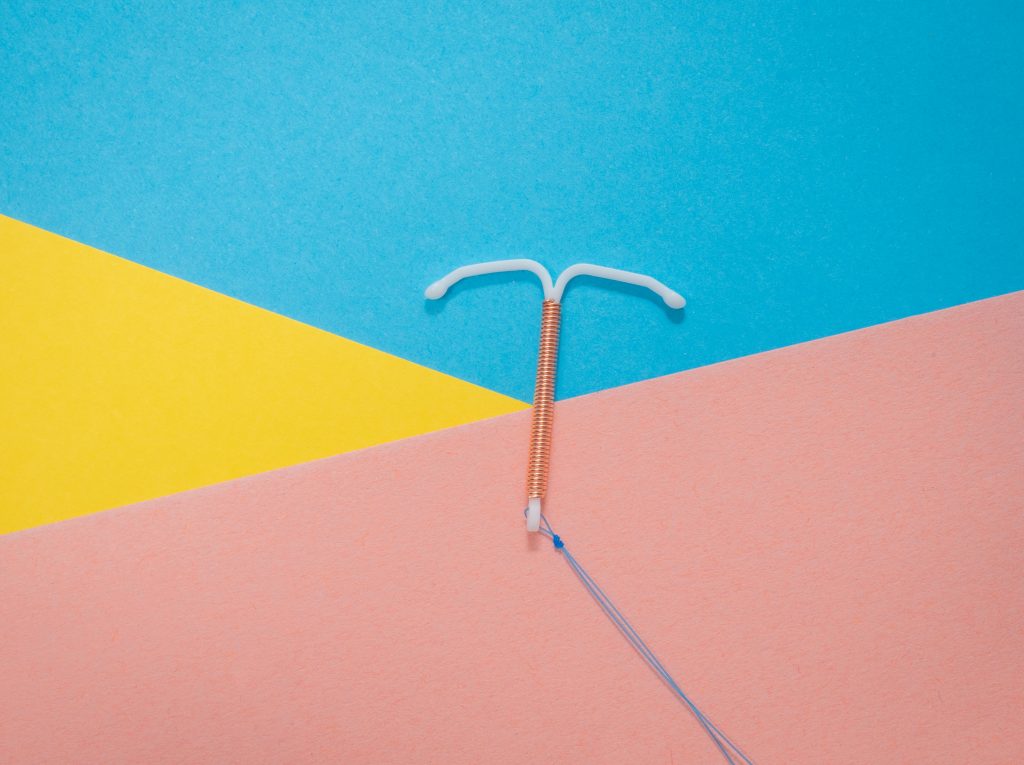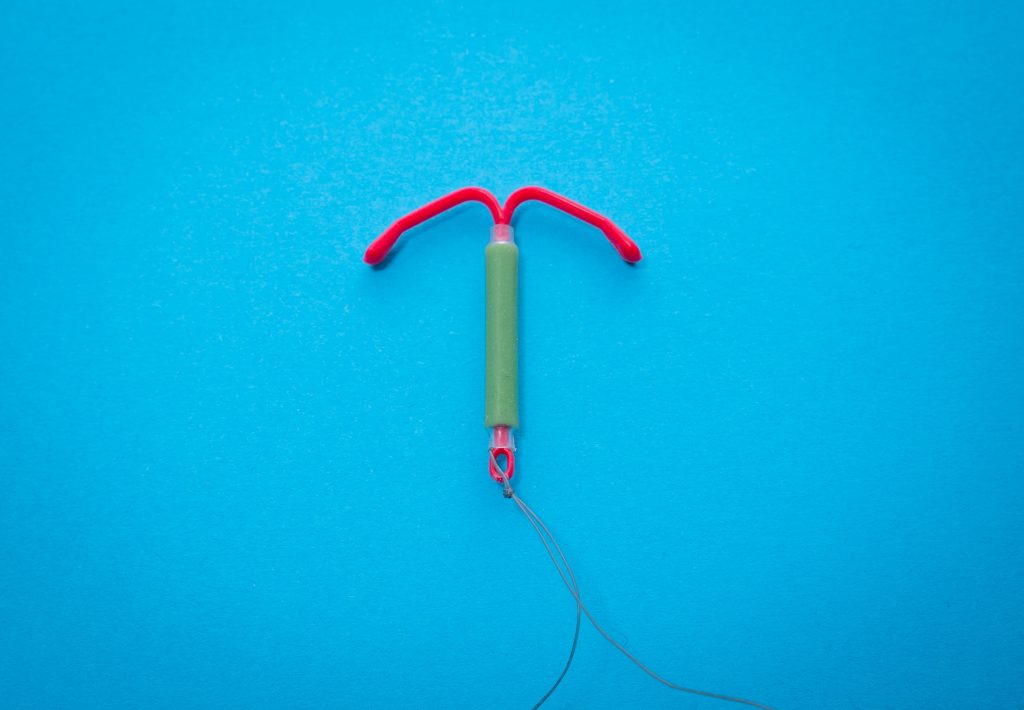
The IUD is a highly effective, long lasting form of birth control. The two different types, the hormonal IUD and the copper IUD, function in different ways, resulting in differing advantages and disadvantages. The IUD must be inserted by a trained health care professional, and it does not prevent against sexually transmitted infections (STIs).
Table of Contents
What Is an IUD?

The IUD, or intrauterine device, is a small, T-shaped object that a health care professional places in the uterus in order to prevent pregnancy. It can be used as a long-term method of birth control, or it can be used as an emergency contraceptive. The IUD is long lasting and very effective. It does not, however, prevent sexually transmitted infections (STIs) and should be used in tandem with a male or female condom. There are two different types of IUD: the copper IUD (ParaGard) and the hormonal IUD (Mirena, Liletta, Skyla, and Kyleena). The two work in slightly different ways, and have different advantages and disadvantages.4
How Does It Work?
Both the hormonal and copper IUD make an inhospitable environment for sperm. The hormonal IUD thickens cervical mucus to prevent sperm from fertilizing the egg; the copper ions from the copper IUD inhibit sperm motility to prevent sperm from fertilizing the egg.
Hormonal IUD
Hormonal IUDs, including the Mirena, Liletta, Skyla, and Kyleena, work by releasing a small amount of a progestin hormone called levonorgestrel. Levonorgestrel thickens a female’s cervical mucus, preventing sperm from penetrating the egg. It also thins the endometrial lining, reducing or preventing implantation of a fertilized egg. This process can make menstrual periods lighter, less frequent, or even stop all together. The hormonal IUD releases progestin locally to the uterus, so that only small amounts enter the blood stream. Because of this localized exposure, the hormonal IUD has far fewer side effects than other hormonal forms of birth control, such as the pill. The device may remain in place for three to five years depending on the brand.3
Copper IUD
The copper IUD, also known as the ParaGard, uses copper wire wrapped around the T-shaped frame to act like a spermicide. The copper ions inhibit sperm motility and prevent them from traveling through the cervical mucus. It contains no hormones, but can make menstrual periods heavier and more painful. The copper IUD may remain in place for up to 10 years.2
Emergency Contraceptive
The copper IUD can also be used as a method of emergency contraception to prevent pregnancy. A trained clinician can insert the copper IUD up to 5 days after unprotected sex or primary birth control failure. This method is more effective than any type of emergency contraceptive pill, such as the morning after pill, as it reduces the risk of pregnancy by more than 99%. It is the most effective way to prevent pregnancy after unprotected sex. After insertion, the IUD may be left in place and used as a method of primary birth control.1
Effectiveness
IUDs are highly effective. The hormonal IUD has a typical-use effectiveness of 99.9% (only 1 out of 1000 females will become pregnant in a given year), making it even more effective at preventing pregnancies than female sterilization (99.5% effective). The copper IUD has a typical-use effectiveness of 99.2% (8 out of 1000 females will become pregnant in a given year).5 This form of birth control requires little to no routine action to function properly; there is no pill to take or patch to switch out. Because of this, typical-use effectiveness is very close to perfect-use effectiveness. This means the human error portion of its effectiveness is minimized significantly.
Advantages
Some advantages to the IUD include the following:
- The IUD is highly effective in preventing pregnancy.
- It can remain in place for years at a time (3-5 years for the hormonal IUD and 10 years for the copper IUD).
- It can be used as an emergency contraceptive.
- It is easily reversible. It can be taken out at any time by a health care professional, and fertility resumes almost immediately after removal.
- It can be used during breastfeeding.
- It requires no daily action to maintain effectiveness – only monthly thread checks to ensure it is still in place.
- The hormonal IUD may decrease the duration and intensity of menstrual flow.
- The cost of the IUD ($500-$1000 for five years) is less than that of using birth control pills for the same amount of time ($900-$3000 for five years).
To check out the advantages of other forms of birth control, see our birth control comparison chart.
Disadvantages
Some disadvantages to the IUD include the following:
- The IUD does not offer any STI protection.
- There may be cramping and irregular bleeding for the first 3-6 months after insertion.
- It can increase the risk of ectopic pregnancy.
- It carries a small risk of uterine perforation.
- The copper IUD may increase the duration and intensity of menstrual flow.
- There may be a high up-front cost depending on insurance coverage.
To check out the disadvantages of other forms of birth control, see our birth control comparison chart.
How To Get One

Before insertion, be sure to thoroughly research the IUD and and make an appointment with a health care professional. Slight discomfort is common during insertion, but the process only takes a few minutes. Afterwards, expect light spotting for a few days after the procedure; be sure to check the strings to ensure the IUD is still properly in place.
Before Insertion
Before you decide to get the IUD, be sure to research it thoroughly; know its disadvantages, advantages, and side effects. Talk with your doctor or visit Planned Parenthood to discuss which IUD will work best for you. Then, come up with a payment plan depending on insurance coverage and upfront cost. The upfront cost of an IUD can range from $500-$1000. Medical insurance or student health centers can greatly diminish this cost, and maybe even fully cover the procedure. Talk to your insurance providers or call your university health center to explore your cost options. If you live in the United States, you can also contact a Planned Parenthood near you.7
Insertion
The IUD must be inserted by a trained healthcare professional, so if you have decided that you want the IUD, make an appointment with your doctor. The doctor will perform a bimanual examination by inserting two fingers into the vagina, while placing the other hand on top of the abdomen to feel the pelvic organs. This allows the doctor to determine the position and size of the uterus for IUD placement. The vagina will be held open using a speculum device (“duck lips”). An antiseptic will be used to clean the vagina and reduce risk of infection, and a local anesthetic gel may be applied to decrease sensitivity. The interior space of the uterus is then measured to assure proper IUD placement and reduce the risk of the IUD perforating the uterus. Finally, the IUD is passed through the cervix with an inserter. Once the IUD reaches the uterus, the inserter is removed and the IUD expands into a T-shape. A plastic thread is attached to the bottom of the IUD and trails through the cervix. Women using an IUD as a method of birth control must check that this thread is in place after every period to make sure the IUD is secure and has not shifted.6
It is common to feel slight cramping or pinching as the IUD is put into place, but the entire procedure takes only a few minutes. Since most females experience only slight discomfort, it is usually okay to drive and resume daily activities after the procedure. It is advisable to bring a sanitary pad from home in case some bleeding occurs after insertion.6
After Insertion
Bleeding and spotting is normal for the first few days following IUD insertion. If the bleeding is constant or heavy, it is important to contact a healthcare provider. A follow-up appointment after the first period or between 4-6 weeks after insertion should be scheduled to ensure that the IUD is properly in place. If the IUD is going to fall out, it will typically do so during the first few months of use and following menstrual bleeding.
You should check your strings monthly in order to ensure the IUD is still in place. Wash your hands and get in a comfortable position. Place your index finger deeply into the vagina until you feel your cervix (it should feel rubbery like the tip of your nose). If you feel the strings emerging from the cervix, then the IUD is in its proper position. Never pull on the strings, as this could shift the IUD out of place.6
Concluding Remarks
The IUD has a high upfront cost, but it can last from three to ten years and cost less than using the contraceptive pill for the same amount of time. Though it does not protect from sexually transmitted infections (STIs), it is highly effective in preventing unwanted pregnancy. The IUD must be inserted by a healthcare professional, so consult with your doctor and make an appointment. Make sure to consider the advantages and disadvantages of the two types of IUDs before making your decision.
For more on the IUD, watch the video below!
References
1. “Emergency Contraception: Copper T IUD as Emergency Contraceptive.” Princeton University. The Trustees of Princeton University, 30 June 2016. Web. 24 Jan. 2017.
2. Parenthood, Planned. “IUD Birth Control – Mirena IUD – ParaGard IUD.” Birth Control – Mirena IUD – ParaGard. Planned Parenthood Federation of America Inc., 15 Dec. 2016. Web. 24 Jan. 2017.
3. “Effective Birth Control without a Daily Pill.” About | Mirena® IUD. Bayer, Sept. 2016. Web. 24 Jan. 2017.
4. Kennedy, Sara. “ParaGard vs Mirena: Which IUD Is Best for You?” Bedsider. N.p., 29 Jan. 2010. Web. 24 Jan. 2017.
5. LeVay, Simon, Baldwin Janice, and Baldwin John. “Chapter 9: Contraception and Abortion”. Discovering Human Sexuality. Sunderland: Sinaur Associates, Inc., 2009.
6. Parenthood, Planned. “What Happens during an IUD Insertion?” Planned Parenthood. Planned Parenthood Federation of America Inc., 13 Oct. 2016. Web. 24 Jan. 2017.
7. Parenthood, Planned. “How Can I Get an IUD?” Planned Parenthood. Planned Parenthood Federation of America Inc., 10 Aug. 2016. Web. 24 Jan. 2017.
Last Updated: 24 February 2017.
